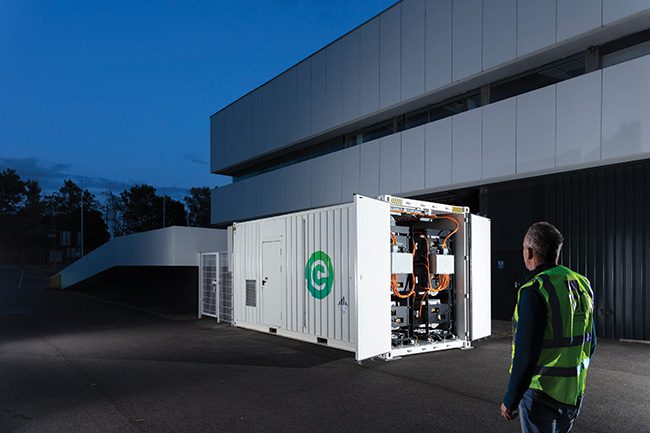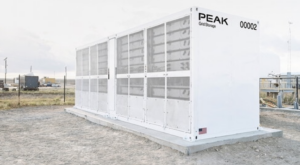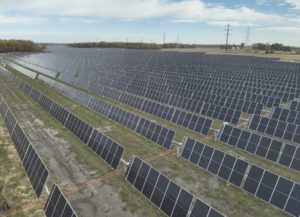Does it really make sense to manufacture new batteries for energy storage systems when a much better alternative is already available? How second-life electric vehicle (EV) batteries can enhance energy security and the circular economy.
Globally, battery energy storage is a rapidly growing segment of the power industry. Battery energy storage systems (BESS) are valued for their capabilities on microgrids right through to utility-scale applications. Smaller systems can provide power for electric vehicle (EV) charging hubs or business operations in areas of restricted grid capacity, or enable businesses and homeowners to make the most of their rooftop solar photovoltaic (PV) arrays.
Fundamentally, these BESS can help prevent grid constraints from derailing corporate decarbonization objectives. Industrial and commercial facilities located on older estates or business parks often do not have sufficient headroom on their grid connection to add new plant equipment, or a bank of EV charge points. In these cases, a BESS can be a highly cost-effective and low-carbon method of accessing that additional power, as opposed to a lengthy and costly connection upgrade.
However, increasingly, we are also witnessing much larger BESS deployed to help optimize wind and solar farms. Known as grid or utility-scale storage, this is vital to improving the return on investment from renewables. BESS provide the infrastructure to store surplus energy generated during periods of low demand, and release it as and when it is needed on the grid.
Substantial Growth
Deployment in developed nations is happening at a rapid pace, so it’s important to understand the context. According to analysts with Dimension Market Research (DMR), the global energy storage market was forecast to reach $58.9 billion in 2024 and will hit $204.8 billion by 2033. DMR believes that grid energy storage accounted for 36% of market share last year.
Drilling down, the U.S. market had an estimated value of $21.9 billion last year—more than 44% of the global total—and could reach $70.7 billion within a decade. Looking at Europe, we can see a similar picture. According to SolarPower Europe, the European battery storage market is expected to grow to a total installed capacity of up to 135 GWh in four years, and to 78 GWh in its medium-growth scenario. Its figures show that BESS with a capacity of 17.2 GWh were installed in 2023, almost twice what was achieved the previous year. The total installed capacity in Europe was 35.8 GWh. For 2024, the industry association estimates that at least 22.4 GWh was added across Europe, an increase of 31%.
Until now, growth in BESS deployment was driven by residential storage systems. According to SolarPower Europe, household BESS had a 70% market share of newly installed capacity in 2023, but this is expected to fall to under 30% by 2028. Utility-scale grid storage systems will replace it with 45% of new BESS capacity, more than doubling its numbers from 2023.
In the vast majority of applications, these grid storage systems use brand-new batteries. However, at Connected Energy, we believe there is a strong case for using second-life batteries instead, and there is an abundant source of these batteries in EVs. It is expected that more than 100 million EV batteries will be retired in the next decade, a significant percentage of which could be repurposed into stationary storage. The market for spent EV batteries has the potential to be an exciting, high-value sector extending beyond the current limits of recycling.
Repurposed Batteries Make Sense
The three main pillars of the argument in favor of second-life BESS are performance, energy security, and the circular economy.
Performance. EV batteries degrade over time. However, when an EV reaches the end of its life, the batteries typically still have up to 80% of their original energy storage capabilities. By linking multiple battery packs together, and combining them with an intelligent management system (Figure 1), we can create BESS that are suitable for a range of applications. This could be 300-kW systems for powering EV chargers in rural areas, right through to multi-megawatt BESS at utility scale.
 |
|
1. Intelligent energy management systems allow battery energy storage systems (BESS) to operate more effectively and efficiently. Courtesy: Connected Energy |
Because these applications are less taxing than powering an EV, the batteries can comfortably last at least another 10 years in a BESS. Connected Energy has been working with second-life batteries since 2010, so we can say this with confidence based on the years of real-world data we have accumulated.
As anyone in the industry recognizes, safety is paramount, and second-life systems come with the highest in safety standards. This is because EV batteries are typically manufactured and tested to higher standards, as they have to meet automotive safety regulations. The batteries are designed to be robust and their battery management systems developed to act as early warning systems against thermal runaway. EV manufacturers are actively engaged in exploring new avenues to repurpose batteries, meaning that second-life BESS developers benefit from the original battery management systems and safety standards.
Energy Security. Second-life BESS is also a solution to energy security. In Europe, this challenge was crystallized by the Ukraine war, where consumers saw rapidly escalating energy price inflation due to reliance on Russian gas.
By supporting deployment of renewables, BESS reduces reliance on imported energy from foreign states. As more renewables are deployed, energy generation becomes more dispersed. Battery energy storage provides the control mechanism to give the grid resilience by balancing energy demand with generation.
But the batteries for these BESS—or the components and materials within them—are still predominantly coming from outside of North America and Europe. If geopolitics leads to a scenario where this supply chain is no longer accessible, then a key plank in many countries’ renewable energy strategies is lost.
Thankfully, the ongoing transition to EVs has created a huge reservoir of resources in the form of second-life EV batteries. Once a vehicle reaches end of life, its batteries can be repurposed in BESS, providing a second life that could last a decade or more. Based on the International Energy Agency’s (IEA’s) 2024 global EV outlook report, there is already more than 500 GWh of EV batteries in Europe. This is enough to meet all of the region’s BESS requirements.
The road to resilience begins with leveraging the opportunities already in our grasp. By repurposing second-life EV batteries for energy storage (Figure 2), we can secure not just our energy independence, but our global competitiveness in the green economy.
 |
|
2. Containerized BESS can be deployed at commercial and industrial sites, as well as for utility-scale applications. Courtesy: Connected Energy |
Circular Economy. As we move from a “make-and-waste” to a “cradle-to-grave” ethos, it makes sense to extend the useful life of every product before it is recycled. In the case of EV batteries, this means repurposing them in a second life as stationary energy storage.
Market analysts with McKinsey estimate that, in 2025, there will be 800 million pounds of EV batteries ending their first life applications. Naturally, this will only increase, mirroring the EV adoption curve. In 2035, this figure will grow to 3,400 million pounds, and 7,300 million pounds by 2040.
The potential for positive environmental impact by reusing as many of these batteries as possible is enormous. For example, 800 million pounds amounts to about 40.8 GWh of second-life battery capacity. Assuming that even 25% of these batteries are reusable, that would deliver estimated savings of 816,000 tonnes of CO2 compared to using first life batteries.
[Ed.: The article originally mistakenly referred to the masses of EV batteries in tonnes instead of pounds, which caused some calculations to be off by a factor of about 2,205. Corrections were made on 4/17/2025.]
Given the environmental impact of mining the precious metals required to create lithium batteries, there is a strong case for finding ways to reuse or recycle these products. It will also give our recycling industry the time it needs to mature.
The IEA estimates that total global capacity for recycling EV batteries stands at 180,000 tonnes (396.8 million pounds) per year. It warns that, by 2040, there could be 1,300 GWh worth of batteries no longer suitable for EV use, far exceeding the recycling industry’s current capabilities. In this scenario, second life becomes even more valuable. By creating a meaningful second life for EV batteries, we close the loop, creating a true circular economy for these important resources.
Realizing Value
An additional benefit of second-life BESS is that it supports the electrification of transportation. Put simply, at present, an EV battery costs money to recycle. This will change over time, but right now that battery pack has a negative scrap value. Conversely, by monetizing those EV batteries in a second-life BESS, we are adding value to the battery pack at vehicle end-of-life. Suddenly, former EV batteries move from the liability column into the asset column. Once the automotive industry gets to grips with this change, it should impact the entire value chain—and specifically, the vehicle leasing model that is so important to the EV market.
Overall, giving batteries a second life realizes more value from the embedded resources and displaces the environmental impact of new battery production. It delays recycling until the industry has developed more efficient and cost-effective processes, while also improving the overall economics for our transition from fossil fuels to all-electric vehicles.
—Matthew Lumsden is CEO and founder of Connected Energy, a provider of second-life BESS to the public and private sectors in the UK and Europe.











